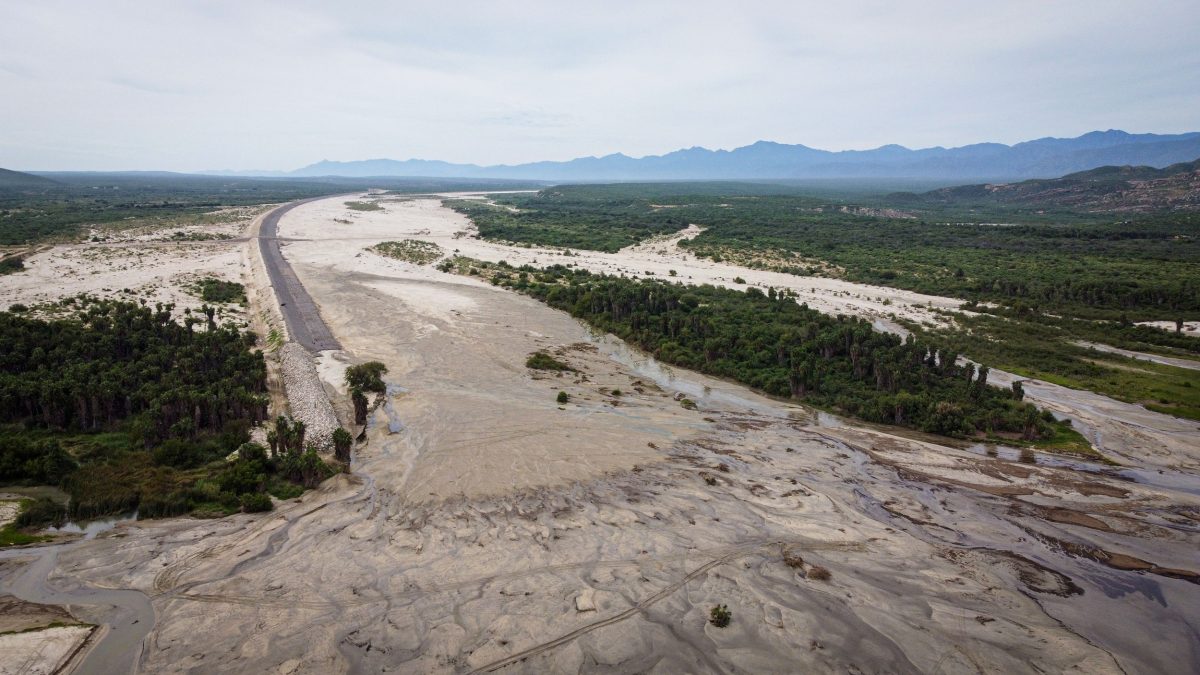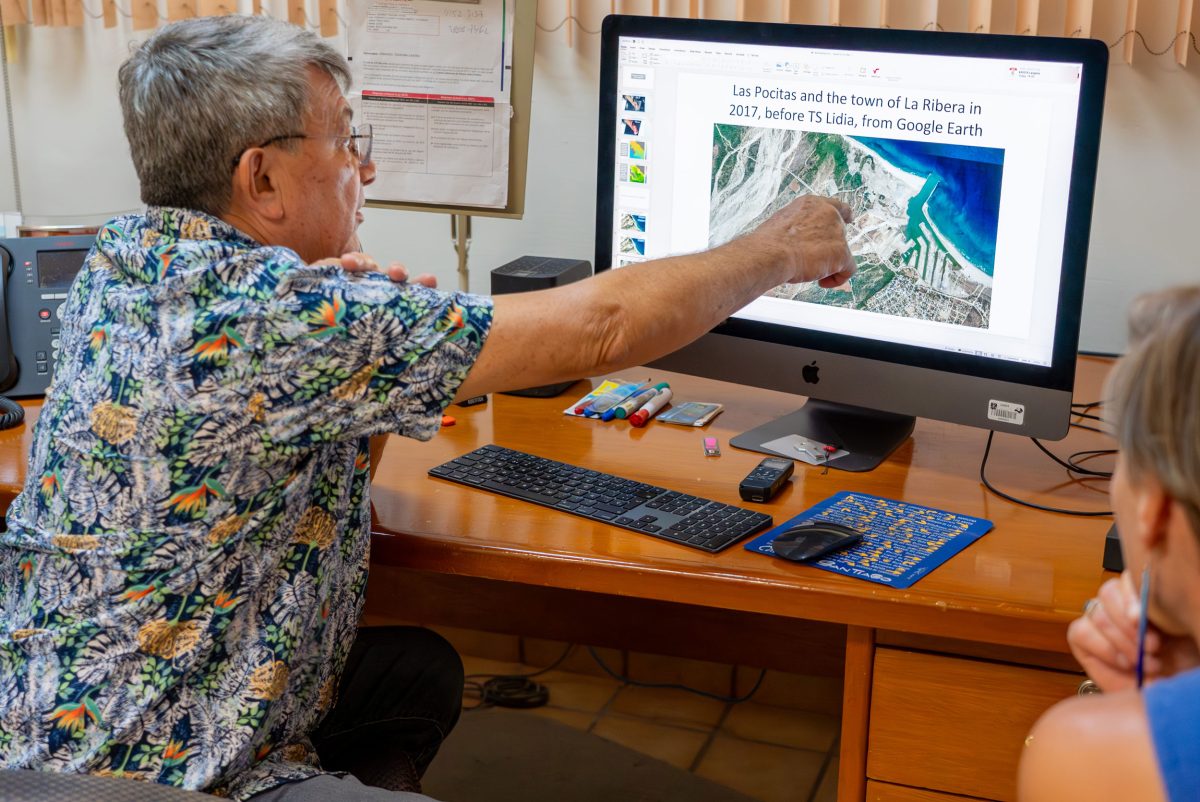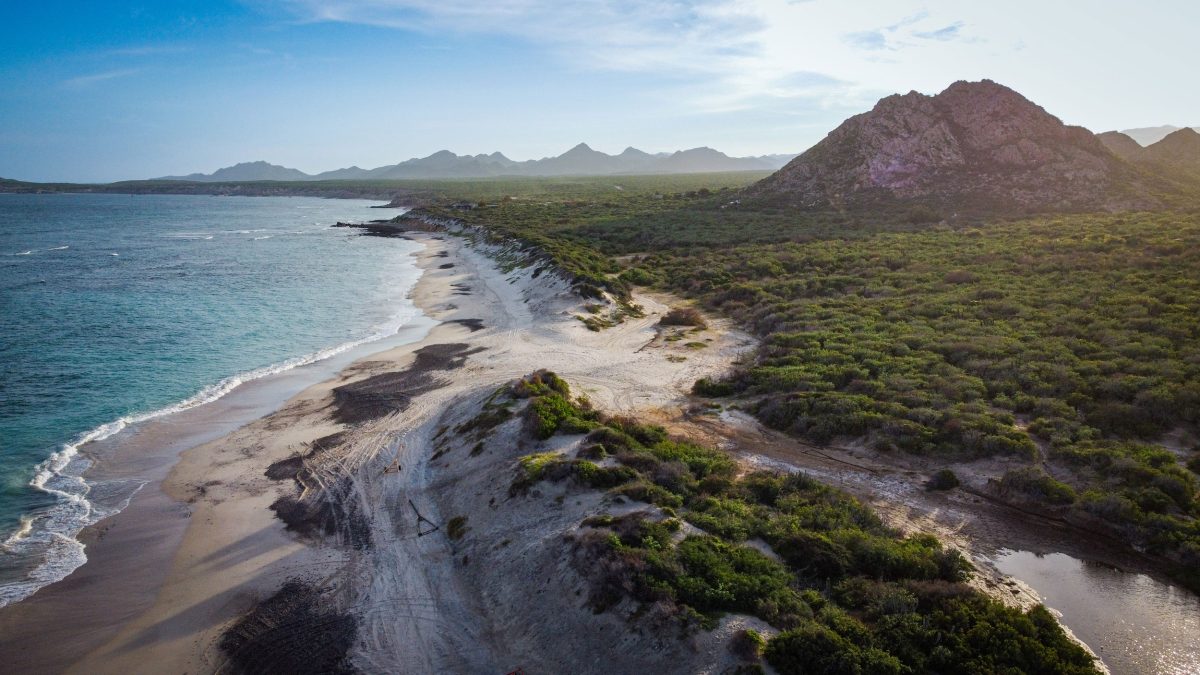36 KiB
| dg-publish | Alias | Tag | Date | DocType | Hierarchy | TimeStamp | Link | location | CollapseMetaTable | ||||
|---|---|---|---|---|---|---|---|---|---|---|---|---|---|
| true |
|
2024-06-02 | WebClipping | 2024-06-02 | https://hakaimagazine.com/features/buying-baja/ | true |
Parent:: @News Read:: 2024-06-10
name Save
type command
action Save current file
id Save
^button-BuyingBajaNSave
Buying Baja
On a storied stretch of Mexico’s Baja peninsula, locals fight rich outsiders and rampant development that threaten to transform the coast and dry up aquifers.
The fish are so thick we can see them from the boat, a writhing mass darkening the ocean’s surface, their oily smell rising into the air. Our guide counts us down—“uno, dos, tres!”—and we slip overboard. Within moments, a thousand or more bigeye jack surround us, all slippery silver bodies and trailing fins, unblinking eyes and downturned mouths, below us and in front of us and on either side of us. They all face the same direction, the whole school turning and changing shape in concert like an underwater version of the murmurations of birds that paint the sky with their collective motion.
Individually, each jack is as unremarkable as a child’s drawing of a fish: bullet shaped, a half-meter long, relatively common in the tropics. Together, they’re breathtaking. They become waves of fish, swirls of fish, tornadoes of fish. At times, I can’t see the blue of ocean behind the wall of their bodies. To be among so many animals at once is to be reminded of the dazzling abundance that still exists in the world.
I lift my face from the water and get my bearings: a sea that seems made of light, the tawny mountains of the Mexican state of Baja California Sur rising in the distance. A few snorkels poke up around me.
“Chicos, over here!” our guide calls. “Tortuga!” I reach her just in time to see a hawksbill turtle drift by. Later, we’ll glimpse several more sea turtles, along with a spotted eagle ray, a green moray eel, parrotfish, pufferfish, angelfish, corals, sea fans, and small, colorful darting creatures too numerous to count. The reef below, as John Steinbeck wrote in The Log from the Sea of Cortez, “skittered and pulsed with life.”
The biodiversity packed into this sliver of ocean is partially a result of underwater geology and currents that allowed the only true coral reef in the Sea of Cortez (also called the Gulf of California) to form here some 20,000 years ago. Equally important, however, is a nearby village called Cabo Pulmo. In the 1980s, fishermen whose families had lived in Cabo Pulmo for a century began noticing that they were catching fewer fish, as well as spotting fewer sharks, turtles, and rays. Corals were increasingly damaged by anchors. Then the village’s story took a surprising turn: residents decided to stop fishing the reef and go all in on conservation and ecotourism.
Given that Cabo Pulmo had virtually no tourist facilities, had no store or gas station, and could only be reached by driving many kilometers of washboarded, sandy roads, it was a gamble. In 1995, however, the Mexican government designated 71 square kilometers of ocean as a national marine park. Locals helped implement and enforce a fishing ban within the park’s boundaries, and they educated visitors on responsible diving and snorkeling. By 2009, researchers from the Scripps Institution of Oceanography at the University of California San Diego found that fish biomass had jumped 463 percent—the largest increase ever documented in a marine reserve. The biomass of top predators like sharks increased tenfold.
People benefited as well. In the 1970s, Cabo Pulmo had only six houses. Today, 300 people live in the village, which now has its own elementary and middle school and a variety of locally owned restaurants, dive outfitters, and guest houses for rent. There’s an economy, in other words, that allows residents to stay put instead of migrating to cities for work or school as they did in the past. And Cabo Pulmo remains charmingly rustic. There are no hotels. Chickens, goats, and dogs wander freely, children play soccer on the unpaved roads, and electricity comes largely from rooftop solar. The stars at night are brilliant. The village and its eponymous park are now a UNESCO World Heritage Site, lauded by conservation luminaries in Mexico and abroad.
Kids play soccer on the main drag of Cabo Pulmo, in the Mexican state of Baja California Sur. The village has no pavement or traffic lights and is powered largely by rooftop solar.
“This is a perfect example of what a community that belongs to a place [can] do,” says Judith Castro Lucero, who grew up in Cabo Pulmo and whose family was instrumental in protecting it. “Because we belong to this ocean.”
For a long time, Cabo Pulmo’s location also aided its success. The Cabo del Este—or East Cape—region surrounding the park is a quiet stretch of desert and sea peppered with small towns and villages. Guidebooks gush that it offers a taste of “old Mexico,” conjuring images of scattered ranchos where leather-faced cowboys round up scrawny cattle and of empty beaches where intrepid campers can buy dinner directly from fishermen. Research shows that compared with other subtropical regions, the East Cape’s coastal habitats as a whole have remained relatively intact, rich with fish and comparatively free of pollution.
Judith Castro Lucero’s family was instrumental in creating Cabo Pulmo National Park.
Yet, the East Cape is beginning to change, and rapidly. Real estate speculation; megaresorts; and unplanned, poorly planned, and possibly illegally planned developments threaten to displace people and harm biodiversity—potentially even in the waters that Cabo Pulmo has fought so hard to protect. As local activists try to rein in the worst projects, they’re confronting competing visions for the region’s future. Will tourism and gentrification consume the East Cape as they have so many other coastal destinations? Or can people find ways to welcome some growth while still preserving the intricate connections between the desert, the sea, and the human communities that care for them both?
The 1,200-kilometer-long peninsula of Baja California juts south from the US state of California like a crooked finger pointing toward the equator. Geographically, culturally, and even geologically, it is distinct from mainland Mexico. Arid mountain chains form its spine, crashing into the Pacific Ocean to the west and the more protected waters of the Sea of Cortez to the east. Arroyos—dry riverbeds that intermittently flood with rainfall—funnel fresh water from the mountains to the coast, carrying sediments and nutrients that replenish beaches with sand, feed marine life, and recharge the aquifers that people depend on for drinking water.
These ephemeral threads tying together desert and sea are even more valuable because of the scarcity of freshwater. Eighteenth-century Jesuit missionary Jakob Baegert described Baja as “a pathless, waterless thornful rock, sticking up between two oceans,” and his observation remains fairly accurate today. The state of Baja California Sur, which makes up the southern half of the peninsula, is especially dry and sparsely populated, claiming both the longest coastline and the least fresh water of any Mexican state. For centuries, its aridity and imposing topography isolated it from the rest of the world. Getting to Baja Sur from nearly anywhere else required a boat, a small plane, or a long journey in a four-wheel-drive vehicle.
Map by Mark Garrison with data from ArcGIS
“Baja is a splendid example,” commented early 20th-century naturalist Joseph Wood Krutch, “of how much bad roads can do for a country.”
That isolation began to erode in the 1970s, when the Mexican government decided to boost the economies of the nation’s poorest states by turning a handful of communities into seaside tourism hubs. One of them was Los Cabos, roughly 100 kilometers south of Cabo Pulmo on the southern tip of Baja Sur. With help from the World Bank, the government improved roads, built an international airport, and offered incentives for real estate developers. Mass-market hotels, luxury hotels, second homes, marinas, and golf courses followed. In 2022, over three million visitors came to Los Cabos, and many never left their all-inclusive resorts.
Yet the rebranding of Los Cabos from a fishing and agricultural community into a glitzy resort destination came at a cost. Because some construction interfered with the flow of water from the mountains, aquifers and certain beaches shrank, and fewer nutrients reached the sea. Hotels effectively walled off much of Los Cabos’ 32-kilometer coastline, defying state and local zoning regulations (known as ordering plans) meant to ensure coastal access and protection. Mexican families who had lived or fished in the area for generations were forced inland.
Tourism workers, meanwhile—many of whom migrated from elsewhere in Mexico—settled in cordones de miseria (“belts of misery”) on the city’s outskirts, where they frequently live without running water in a place where temperatures can soar to over 37 °C. In 2006, 15 percent of local households lacked potable water, while hotels watered lawns and flushed toilets with abandon. Ecosystems suffered, too. As of 2022, Los Cabos had the lowest recorded fish biomass out of 76 sites across Baja Sur where scientists collected such data.
Cabo San Lucas is one of two towns that make up a 32-kilometer stretch known as Los Cabos at the southern tip of Baja, Mexico. Photo by Frederick Millett/Alamy Stock Photo
Until recently, this sort of unchecked development was largely constrained to Los Cabos. Driving north toward Cabo Pulmo and beyond, the East Cape has maintained an almost mythological reputation. Bone-rattling roads keep crowds at bay, and the region’s 20,000 or so residents can still spend weekends picnicking, swimming, fishing, and camping freely on beaches that stretch unbroken for miles. Working-class people can still live in modest homes with an ocean view.
Or at least they could, until Los Cabos–style development began creeping north.
Reina Macklis is waiting for me in her battered gold Subaru in a mostly dry arroyo just outside La Ribera, the town closest to Cabo Pulmo. I follow Macklis as far down the arroyo as I can in my rental car, then park next to some Mexican fishermen who say they’ve come here from Los Cabos, over an hour away, because their own waters are too polluted to fish. Macklis—an environmental activist who grew up in La Ribera—says this happens often, and she fears similar pollution may soon taint her hometown waters. A Los Angeles–based investment firm called Irongate is in the midst of building a megadevelopment known as Costa Palmas between La Ribera and the arroyo. (Irongate did not respond to requests for comment.)
When it’s complete, Costa Palmas will look more like a small, exclusive city than a resort. It will include two luxury hotels and nearly 400 private homes, priced from US $2.5-million to $26-million. According to the New York Times, it will also boast “polo fields, a horseback riding center, several organic farms, a kids club, and scenic walking paths,” as well as 20 restaurants, a golf course, a pool, a gym, a movie theater, and a 250-yacht marina with an exclusive club. It will span three kilometers of beach.
The Costa Palmas megadevelopment is under construction outside La Ribera, a town near the southern tip of Baja California Sur.
On this warm, overcast morning, Macklis has agreed to show me and photographer Kristina Blanchflower how Costa Palmas is already affecting local people and ecosystems. She starts by pointing out a 5.7-kilometer-long stone wall several meters high that construction workers are building alongside the arroyo. Typically, when the arroyo floods, the water disperses into an estuary of Mexican fan palms, mangroves, and wetlands. But because the flooding arroyo would put the golf courses and buildings of Costa Palmas at risk, the wall is being built to channel water away from them.
Unfortunately, a concentrated flood passes through more quickly than a dispersed one, which keeps it from percolating into the aquifer that supplies La Ribera’s drinking water. Costa Palmas draws from the same limited aquifer, and since parts of the resort opened, Macklis says she and other La Ribera residents have run out of water—sometimes for a few days, once for two weeks. A single golf course, meanwhile, uses enough water every day to supply 9,000 Baja residents.
The Santiago arroyo, just outside La Ribera, feeds one of Baja California Sur’s most ecologically important wetlands. A new wall, at the left, aims to control the flow of water in the arroyo.
And Costa Palmas is far from the only new golf course in the East Cape. As of 2022, state and municipal governments had approved permits for nine additional golf courses, with 18 more under consideration. They’d approved nearly 12,500 hotel rooms, with another 25,000 in the permitting process, and 10,000 new houses, with 20,300 more in permitting.
Thanks largely to such development, the population of the East Cape nearly doubled between 2010 and 2020—from 13,800 to 21,000 people—and is expected to surpass 138,000 by 2040. While many of the new residents are construction and tourism workers from other parts of Mexico, the population boom is also driven by second-home owners, investors, digital nomads, and retirees from the United States, Canada, and Europe who put additional pressure on the region’s scant fresh water. Mexico’s 1917 constitution forbids foreigners from owning property within 50 kilometers of the coast, but nonresidents routinely circumvent the law by buying property through a fideicomiso, a trust in which a Mexican bank holds the title to a property in a foreigner’s name.
Walking from the arroyo toward the beach, Macklis points out raccoon and bird tracks in the sand. Leatherback and ridley sea turtles, as well as the endangered gallito marino, or least tern, nest here. “There are a lot of species,” Macklis says in Spanish, pushing her curly salt-and-pepper hair out of her eyes. “A lot of mammals and a lot of birds.” She pauses next to a small wetland edged with mangroves. A great blue heron stands in the shallows, and a flock of migratory ducks rests nearby. The area is also home to the endangered Belding’s yellowthroat, a bright warbler that lives only in the wetlands of Baja California Sur.
And then, abruptly, the wetlands end in a massive construction zone crawling with cranes and bulldozers and men in hard hats. “All that over there was mangroves,” Macklis says. “And they took it all out.”
Satellite images confirm that the verdant wetlands around the mouth of the arroyo shrank drastically as construction of Costa Palmas began. The beach accessible to La Ribera residents also shrank as Costa Palmas’ marina cut off the flow of sediment from the arroyo.
Costa Palmas has changed the area’s social fabric as well. Macklis remembers when La Ribera was a peaceful town, just a bit bigger than neighboring Cabo Pulmo. Now, there are so many newcomers that the school has turned away students. The line for the medical clinic wraps around the building. It’s more dangerous to walk after dark. And Macklis no longer comes to the beach alone. When we get to the edge of the construction zone, where a uniformed man with a walkie-talkie stands guard, she stops.
“I used to come to the beach a lot,” she says. “But not as much now … To come by myself is dangerous. It’s dangerous for me because they know me.”
What she means is that they know she’s tried to document the destruction this project has caused. What she means is that she’s afraid to come to her hometown beach. What she means is that she’s being pushed out.
Blanchflower and I, however, are gringas, and no one is going to stop us from continuing on. So while Macklis returns to her salt-rusted Subaru, Blanchflower and I stroll past the security guard, past the expensive homes in various stages of construction, past the golf course where men in pastel-colored polos cluster on immaculate grass. We walk right into the Four Seasons hotel. Everything is white canvas and rattan and clean, modern lines: the infinity pool, the xeriscaping, the beachside restaurant with bouquets on each table. We see an open-air yoga class, where a flock of slender white women stretch and chatter like birds. We stop at an empty bar to chat with the bartender, who lives in Los Cabos but commutes here five days a week because the pay is better and he’s saving for a house. He tells us this as if it’s part of his job, and his deference makes me uncomfortable. Even though we’re sweaty and bedraggled, people seem to think we’ve spent between roughly $1,500 and $4,000 per night to stay here, simply because we’re white.
The Four Seasons hotel overlooks a golf course and a construction zone.
Meanwhile Macklis is driving to her home that occasionally runs out of water, hoping to get some rest before she shows up for her shift at a shelter for street dogs. She works there because she loves animals, loves this place, and wants only to ensure that it stays habitable for everyone—dogs and humans and birds alike.
Driving back to the small guesthouse we’re renting in Cabo Pulmo, we pass roads that, according to my 2021 atlas, show beach access but which the Costa Palmas development now blocks. We pass belching construction trucks full of rocks and cement. The way quiets as we head south, until finally we’re back on the washboarded road to Cabo Pulmo. My shoulders relax, and I roll down the windows to let in the velvet air.
A hurricane passed over the East Cape two weeks ago, and the desert flushes green from rain. Paloverde and acacia trees intertwine with flowering shrubs and all kinds of cacti. The biggest are elephant cacti, or Mexican giant cardón, which soar more than 19 meters into the air. Vultures scan for food from their upper limbs. Roadrunners dart in front of our car.
Crested caracaras perch atop Mexican giant cardón in Baja California Sur.
Still, even on this quiet dirt road, there are signs of encroaching development. Literally. Every few kilometers, we see another large Se Vende sign. Or, if the landowner is targeting expats, For Sale. If these lots are sold, second homes and hotels could soon surround Cabo Pulmo just as they do La Ribera. During my November visit, developers just a few kilometers away are even clearing land for another proposed megadevelopment similar to Costa Palmas, this one directly abutting Cabo Pulmo National Park.
“Pulmo is an excellent example of how conservation can be very successful,” says Armando Trasviña Castro, an oceanographer at the Ensenada Center for Scientific Research and Higher Education. “But it’s so small, and it’s surrounded by areas that are experiencing very accelerated growth. And that has an impact on what happens inside the protected area.”
Studies indeed show that nutrients entering the ocean from La Ribera’s arroyo, 30 kilometers away, help feed the marine life in Cabo Pulmo’s reef. What happens on land affects what happens in the sea. “The whole environment is connected,” says Sarahí Gómez Villada, a marine biologist with the nonprofit Mexican Center for Environmental Law. If the coast around Cabo Pulmo is transformed into a parade of second homes or a big resort, marine and terrestrial life within the park will likely suffer.
Oceanographer Armando Trasviña Castro uses satellite images to track the impacts of coastal development from his office in La Paz, Mexico.
That evening, I meet Angeles Castro for fresh scallops at an open-air, oceanfront restaurant she owns with her family in Cabo Pulmo. Angeles is Judith Castro Lucero’s cousin; their grandfather helped settle the village. When the cousins were growing up in the 1980s, the kids weren’t allowed to swim unless the beach was clean, like children elsewhere aren’t allowed to watch TV until they tidy their rooms.
Now, I ask Angeles about the For Sale signs we saw earlier. “Our East Cape has been sold, sadly, most of it,” she says. “It used to be ranches here and there, and then just empty land.” She shakes her head. “Why more marinas? Why more hotels? There’s so many in [Los Cabos] already, and look what happens. [Tourists there] go diving and don’t see what they see here, because there is not much fish over there. The whole pull is to come see the natural beauty, but if they’re ruining the natural beauty, there’s nothing left to see. There’s just going to be their fancy hotel.”
Angeles Castro sits in the Cabo Pulmo restaurant she owns with her family.
Angeles worries that developments around Cabo Pulmo could also push her own family away. Beaches in Mexico cannot be privately owned, but there are ways to kick people out. Beach access can be closed or monetized. Real estate prices can rise so high that many Mexicans can no longer afford to rent on the coast, let alone buy their own homes. Or sometimes, newcomers simply make locals feel unwelcome. A social scientist who lives in Baja Sur’s capital, La Paz, told me about some homes built along a beach where she and her daughter had enjoyed camping for years. When they set up their tent, a woman came out of one of the houses, yelling at them in English to get out.
“You know, I thought it would be different,” Angeles says. “I thought somehow we were untouchable. But all these people with money have their eyes on us … They want to protect this place. They want to protect it from us.”
One afternoon, Blanchflower and I visit a barrio called El Caribe, on the outskirts of Los Cabos. The neighborhood started as a squatter camp for construction and hotel workers and grew into a sprawl of cobbled-together dwellings made of sheet metal, cinderblocks, tarps, and other low-cost materials. Women scrub laundry in plastic washtubs outside their homes, and dusty, broken-down cars line the roadsides. Trash blows in the wind and spills from black plastic bags. This is the part of Los Cabos that most tourists never see.
I expected residents to feel bitter that they lived without basic utilities while serving posh foreigners just a few kilometers away, but I hear the opposite. One woman tells me she’s from Mexico City and came here to work in a hotel. She likes it; she thinks tourism is good for the region. While we’re talking, a man named Alejandro approaches, eager to practice his English. He’s from Guadalajara and thinks Los Cabos is paradise. He can go to the beach on his day off, and he built a cinderblock home in El Caribe with two extra rooms—each with its own bathroom—which he rents to local workers for 3,000 pesos ($172) each per month. Two black water tanks squat outside. Every two weeks, he pays 500 pesos ($29) to have them filled. It’s expensive, but it means he never runs out of water like many of his neighbors do.
Alejandro, too, supports the proliferation of hotels, Airbnbs, and investment properties, even if it feels unfair. “All they see from their houses is the ocean,” he says. “I’m like, damn, you’re really rich. And we are poor here … They push us away.”
El Caribe is a neighborhood just outside the tourist district Los Cabos where many tourism workers live.
Inequality is a well-documented byproduct of the mass tourism that’s reshaped places like Los Cabos, Cancun, Puerto Vallarta, and elsewhere. “There are these histories of displacement and dispossession in tourism zones, where local Mexicans tend to get pushed out,” says Ryan Anderson, a cultural and environmental anthropologist at California’s Santa Clara University who has worked in Baja Sur. “That’s kind of the pattern.”
The pattern is so predictable it has a name: Butler’s Tourism Area Life Cycle. Richard Butler, formerly a professor at the University of Western Ontario, coined the phrase in 1980, and scholars have since applied it to tourist-dependent regions from Tunisia to the United Kingdom to Hawai‘i. According to Butler’s model, a place is first “discovered,” then developed. Locals begin to lose control over decision-making, and laborers from elsewhere come to fill new jobs. The number of visitors climbs. At this stage, tourism becomes the dominant economic driver, and the environmental, social, and economic fabric of the original community changes, often to the detriment of locals’ quality of life. In Mexico’s tourist hubs, the resulting inequality is so pronounced that one researcher called it “de facto social and economic apartheid.”
And as Angeles Castro presciently observed, mass tourism can alter a place so thoroughly that it becomes indistinguishable from a thousand other places. Some tourist locales adapt and remain popular, but in other cases, tourists grow disenchanted and move on to somewhere more “authentic.” Although tourist numbers are still climbing in Los Cabos, Anderson believes that visitors’ disillusionment is partially driving the development boom elsewhere in the East Cape. The biodiversity of Cabo Pulmo is part of the appeal; developers tout it as one of the East Cape’s assets. The Mexican government is even proposing to pave the rugged coastal road between Los Cabos and Cabo Pulmo, making it easier for tourists, investors, and expats to reach the region’s isolated beaches and close-knit villages.
After leaving El Caribe, Blanchflower and I try to drive to Los Cabos’ oceanfront, but traffic is atrocious and the hotels are like barricades, impassable unless you’re staying in one. When we finally get within sight of the ocean, there’s nowhere to park without paying $40. It is manicured and clean and safe, but it feels surreal, nightmarish. We flee.
In 2023, state and municipal governments in Baja California Sur announced they would revise several of the ordering, or zoning, plans that determine what can be built where. Previous ordering plans were either nonexistent or were written behind closed doors; this time, governments have opened the process to public review and invited people to attend meetings and submit comments. For the first time in recent memory, locals have a platform for expressing concerns about freshwater scarcity, and for speaking out in favor of public beach access and protections for wetlands, waterways, dunes, and endangered species. For the first time, they have a voice.
Yet, in Mexico, having a voice can be dangerous. In 2022, a global watchdog group found that 54 environmental or land rights’ activists were killed in the country, making it the deadliest place in the world for environmentalists. Some people I talk with are reluctant to let me use their names out of fear for their safety or their careers, including several members of a group of friends I meet one night at a mezcaleria in La Paz.
I join the friends in a courtyard behind the bar, where night-blooming cacti unfurl their white blossoms and people chat animatedly in Spanish over shots of mezcal. A couple has just come from a planning meeting, and after ordering fried grasshoppers, guacamole, and chili-dusted orange slices, they discuss their vision for the future. It’s too late for many of Mexico’s tourist hubs, they say, but the East Cape is a place where people still have a chance to get it right. It’s a place where activists and visionaries might be able to disrupt the predictable patterns of mass tourism and disenfranchisement and ensure that the coast remains a public good, rather than a private resource monetized for the benefit of a few.
“This is possible, that it’s not all like Cabos, no?” another person interjects. “We can imagine and we can dream and we can build a different story, no?”
There are reasons for hope, they add. The mayor of La Paz has restored public access to several beaches that private development had cut off. A greater percentage of Baja Sur’s land area is under environmental protections than anywhere else in the country, and more people are now working to strengthen and enforce those protections. And scientists are documenting the region’s biodiversity to make a case against the most egregious developments.
During my visit, Gómez Villada, of the Mexican Center for Environmental Law, is doing exactly that: collecting data from the site of the proposed megadevelopment at the border of Cabo Pulmo National Park where workers have begun clearing land. “We need to document what is happening at the site, what kind of works are being carried out, what regulations are being violated, what ecosystems or species are being affected,” she tells me. Her work will ultimately make a difference. In January 2024, two months after I leave Baja, the Federal Attorney for Environmental Protection (PROFEPA), an agency that ensures compliance with environmental regulations, will decide that the development is, in fact, illegal. The decision states that it would harm both the national park and sea turtle nesting habitat.
Such successes are heartening, but they also illustrate the challenges that activists face. The construction workers outside Cabo Pulmo initially ignore the ruling and don’t cease work until several weeks later, after a local nonprofit convinces someone from PROFEPA to visit the site.
The new ordering plans, similarly, will only be useful if they’re enforced. Protections on paper have proven meaningless when money is changing hands. Although existing regulations are supposed to protect waterways and wetlands, for instance, Costa Palmas is being built on one of the state’s most ecologically important wetlands. Several people told me that they believe Costa Palmas’ construction is illegal and should never have been permitted. I reached out to multiple government officials, including the state director of PROFEPA, to try to understand why Costa Palmas and other questionable developments were allowed. None agreed to an interview.
Costa Palmas is under construction despite allegations of possible illegality.
Locals, on the other hand, are blunt. While some officials try to enforce the ordering plans, they tell me that others collude with developers or pretend not to notice contraventions. Sometimes, construction begins without the proper permits in hand. Other times, a developer will receive a permit to build, but with stipulations: don’t disturb this particular habitat, for example. If they ignore the conditions, repercussions are rare. There simply aren’t enough resources for the few government officials in charge of enforcing environmental regulations to keep an eye on all the construction underway across the region.
And developers intent on profiting from the East Cape don’t seem to be going away. Many proposed projects pop up again and again with different names and investors, exhausting even the most ardent activists. While big projects like the one near Cabo Pulmo garner the most attention, the cumulative impact of individual homes can be just as great—and harder to defeat. One woman who was part of the “resistance,” as she called it, told me that she’d stopped fighting. “To be very honest,” she texts me, “[my friends and I aren’t] involved in this anymore … It’s just part of the reality out here.”
Back in Cabo Pulmo, cell phone service has been down for at least four days. No one seems bothered by this. It’s Día de los Muertos, Day of the Dead, and the village is hosting an ofrenda (altar) competition. A few dozen residents and a handful of expats stroll down the sandy road under the spill of the Milky Way, moving from one altar to the next.
Evening falls on the undeveloped coastline just south of Cabo Pulmo.
One of the ofrendas is in a little shack at the end of the village’s main road, just before it dead-ends onto the beach. Dozens of votives flicker within, but when I duck through the door, I’m caught by surprise. Instead of photos of a dead relative, laminated placards with illustrations of extinct animals are propped on the tapestry-covered table. There’s the paloma de Socorro, or Socorro dove, last seen in the wild in 1972, and the zanate de lerma, or slender-billed grackle, a wetland bird of central Mexico driven to extinction in the early 20th century. There’s the Guadalupe caracara, a vulture-like falcon that was a close relative of the crested caracara, which still perches in elephant cacti throughout the East Cape.
Children crouch around the ofrenda, listening as a woman explains in rapid Spanish the demise of each species. Even though I don’t understand everything she’s saying, I absorb the gravity of her talk: the lessons that unchecked greed leads to loss; that this place is still flush with biodiversity because of peoples’ connection to their lands and waters; that there are places worth protecting, and doing so doesn’t have to come at the expense of community well-being.
When she’s done, we file out of the close, incense-filled room, and the mood lightens. There will be time for fighting and time for mourning, but tonight is a night to come together. Tonight, seabirds still fly against the darkening sky, and insects still buzz and chirp from the verdant desert. Old women still sit in plastic chairs with paper plates of tamales balanced on their laps. And the children, set free from their somber lesson, run laughing down the sandy roads that still, for now, belong to them.
$= dv.el('center', 'Source: ' + dv.current().Link + ', ' + dv.current().Date.toLocaleString("fr-FR"))


